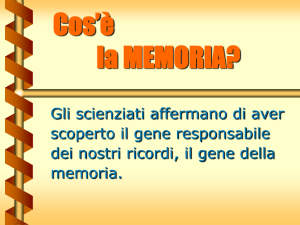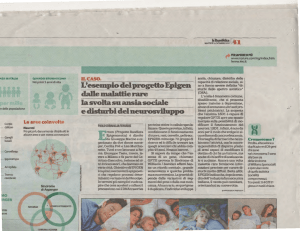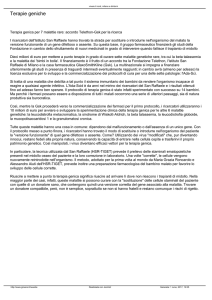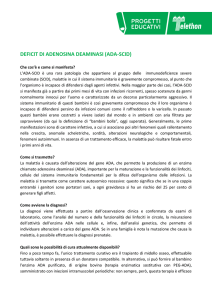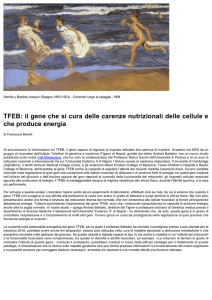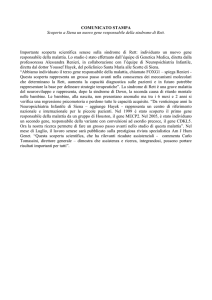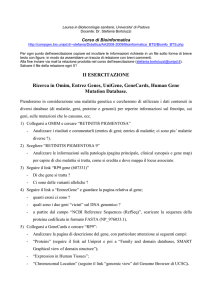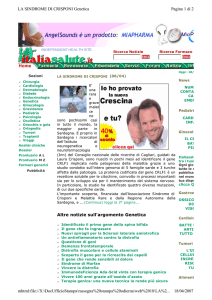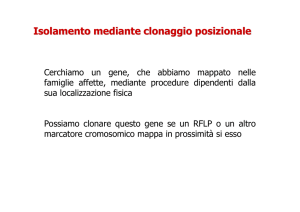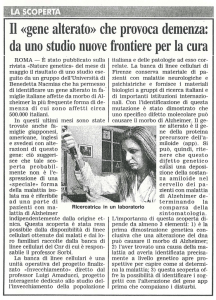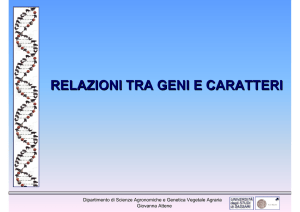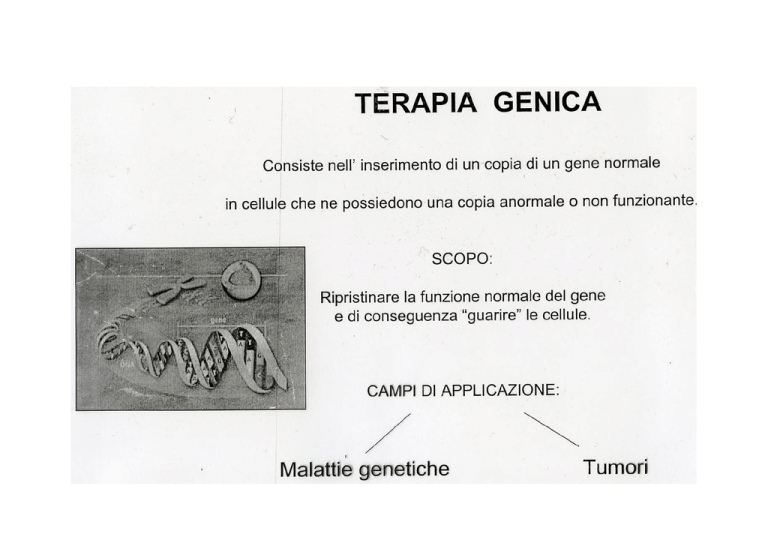
GAIN OF FUNCTION
si ripristina una funzione carente
Vettore di espressione
per cellule animali in coltura
LIPOFEZIONE
Poco efficiente
Integrazione molto rara
Azione di un RICOMBINASI specifica
e delle proteine RAG
Recombination Activated Genes
Topi SCID
(Severe Combined Immunodeficiency)
Difettivi nei geni rag
RETROVIRUS
Doppio strato
fosfolipidico
MEMBRANA CELLULARE
retrovirus
quiescenza
Retrotrasposone
di tipo virale
RETROVIRUS
Parti presenti
nei retrotrasposoni
VETTORE RETROVIRALE
Promotore
retrovirale
Promotore
aggiuntivo
(eucariotico)
Porzione “batterica”
del plasmide
CdKn2a: cycline dependent kinase inhibitor
ONCOSOPPRESSORE
TOPI KO
CdKn2a -/-
FIBROSI CISTICA -
CF
FIBROSI CISTICA -
CF
EMOFILIA
TERAPIA
GENICA
TERRA
Trattamento dei tumori
a livello genico
Knock-out fenotipico di un
ONCOGENE
(proto-oncogene attivato)
TECNICHE DI INTERFERENZA AD RNA
“Loss of function”
Espressione di un
ONCOSOPPRESSORE
(che ha subito mutazioni inattivanti)
TERAPIA GENICA
“Gain of function”
Somministrazione sperimentale
di piccoli RNA interferenti (siRNA)
Meccanismo antico
(solo con siRNA)
che nasce come
difesa da virus e da trasposoni.
Nelle piante è una sorta di
sistema immunitario endocellulare antivirale
In seguito si è evoluto il processo dei miRNA
(sfrutta l’esistenza di DICER e Argonauta)
per la regolazione genica
In alcuni organismi è andato
completamente perso
(S.cerevisiae)
Poi sono arrivati i biotecnologi !
possibilità di
modulare a piacere
l’espressione di specifici geni
Gene therapy is the introduction of genetic material into cells for therapeutic purposes.
Recent scientific breakthroughs
in the genomics field and our understandin
g of the important role of genes in disease has
made gene therapy one of the most rapidly advancin
g fields of biotechnology with great promise for treating
inherited and acquired diseases.
Many human diseases are caused by the absence or inappropriate presenc
e of a protein. The protein could then be administered to patients in order to
compensate for its absence. Today, gene therapy is the ultimate method of
protein delivery, in which the delivered gene enters the body's cells and turn
s them into small "factories" that produce a therapeutic protein for a specific disease over a prolonged period.
As gene therapy has moved from the laboratory into the clinic, several
issues have emerged as central to the development of this technology
: gene identification, gene expression and gene delivery. A number of disease-related
genes with direct clinical have already been identified, and this number is growing
as the field rapidly advances. Genes with broader clinical application are also being
utilized to make cells express immune activating agents locally at the disease site or to
become susceptible to further drug treatment or to immune response recognition.
ALTRO SITO:
http://stemcells.nih.gov/info/scireport/2006Chapter4.html

